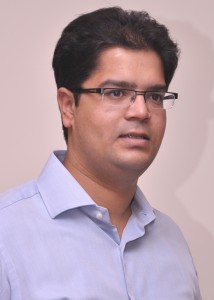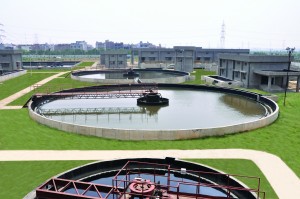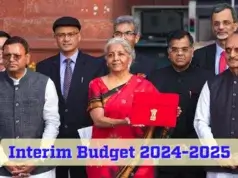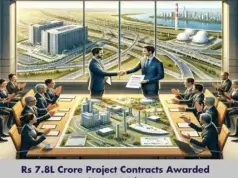 Change is clearly written on the horizon for the water sector all over the world. Specifically, India’s water sector is in need of modern state-of-the-art infrastructure facilities to provide drinking water to the country’s 1.3 billion population, says Rishabh Sethi, Executive Director, SPML Infra Ltd.
Change is clearly written on the horizon for the water sector all over the world. Specifically, India’s water sector is in need of modern state-of-the-art infrastructure facilities to provide drinking water to the country’s 1.3 billion population, says Rishabh Sethi, Executive Director, SPML Infra Ltd.
Water supply system and health safety is critical globally and even more so in India for becoming an economically developed country in the years to come. Historically, India has been endowed with freshwater reserves but the increasing population and overexploitation of surface and groundwater has resulted in water scarcity. With such vast geographical spread, India’s water demand and corresponding market is among the largest in the world with an annual growth rate of approximately 15 to 20 per cent.
Demand for water
India has only 4 per cent of the world’s freshwater resources for its nearly 1.3 billion inhabitants, almost 18 per cent of the world’s population. Water with no substitute continues to escalate at unsustainable rates, driven by economic development, population increase, agriculture growth and industrial expansion. The resources remain constant in terms of quantity whereas the quality is being systematically worsened as a result of human activities and their effects.
The demand for water is subject to three driving forces: rapid increase in population, improvement in quality of life, and climatic change that lead to an increase in extreme events both in frequency and magnitude. We assume that the average domestic water demand would increase from 85 litres per capita per day in 2000 to 125 in 2025 and 170 lpcd by 2050 whereas the urban water demand will be 200 lpcd in 2025 and 220 lpcd by 2050.
India today has the largest agricultural network in the world and is also the largest user of water for agriculture and accounts for about 70 per cent of the total freshwater abstraction. The industry accounts for 22 per cent of freshwater consumption and remaining 8 per cent is used by the households. India’s total water demand will increase by 22 per cent or 833 Bm3 by the year 2025 and to 32 per cent or 900 Bm3 by 2050, from the year 2000 level of 680 billion cubic metres.
With rapid population and industrial growth, the domestic and industrial sectors will account for 85 per cent of the additional demand by 2050. It is also predicted that nine river basins, comprising 75 per cent of the total population, will be physically water-scarce and there will be regions with severely overexploited groundwater resources. Although future food demand can be met, the associated water use patterns will lead to a severe water crisis by 2050. It is projected that India’s population will reach 1.64 billion in 2050; half of them urban and half of them rural would need 9 million hectare metres of water to meet their domestic needs.

Sinking water table
The per capita availability of freshwater in India was 5,177 cubic metres in 1951, which has reduced to 1,820 cubic metres in 2001 and 1,588 cubic metres by 2010-11. It has been projected that per capita water availability is likely to be reduced to 1,341 cubic metres by year 2025 and 1,140 cubic metres by year 2050.
A recent Central Groundwater Board study across the country has a depressing result on the availability of groundwater in the country. Many water bodies and river basins are being exploited beyond their capacity and several of them are considered to be water scarce. Over 80 per cent of the domestic water supply in India is dependent on groundwater which is fast depleting. Water tables have fallen significantly in most areas. The situation is getting worse in Delhi; groundwater that was available at 20 ft deep in 1977 has depleted to 201 ft by 2010 and there is a significant pollution of groundwater from natural as well as manmade sources. The country will thus be water stressed even if the total available water is taken into account.
Treatment of wastewater
With the faster pace of urbanisation in the last one decade, one-third of India’s population has become urban. It is expected that India’s urban population by 2050 will reach 825 million from the existing 340 million. The growth of the Indian economy has also increased water usage across sectors. As a result, wastewater is increasing significantly and the facilities to treat them are not adequate even in the urban areas; the rural areas are not in focus as yet in India for the purpose.
Presently, only about 27 per cent of the generated wastewater is treated; the rest is discharged into ground and water bodies without any treatment. There is an urgent need for better infrastructure and organisation with regard to wastewater management. Most of the existing facilities are conventional and not effective in terms of technology that is being used as per modern standards.
A study on wastewater shows that 71 top Indian cities produces nearly 40,000 million litres of wastewater per day. Whereas, the sewage treatment capacity developed so far is only around 12,000 million litres per day. The Central Public Health and Environmental Engineering Organisation have estimated that 70-80 per cent of total water supplied for domestic use gets generated as wastewater. It is projected that by year 2050, about 132 billion litres of wastewater will be generated per day. This will create a difficult scenario, reduce freshwater availability and increase wastewater. The large gap between wastewater generation and treatment has led to large scale groundwater contamination that causes waterborne diseases in the country, affecting 38 million people annually including the death of 1.5 million children from diarrhoea alone.
PPP in water sector
Large investments are needed to develop and upgrade water supply, treatment and distribution networks. Since most urban water service providers are government-owned or regulated bodies, it becomes difficult to develop and maintain the infrastructure with complete government support and in many cases the required resources are not available. This has forced government to look for support from private sector for infrastructure development and public services through public-private partnerships.
SPML is executing a number of PPP projects in water sector and has demonstrated that efficient management along with proactive operation and maintenance can improve water management and distribution services.
Steps for the success of PPP
Projects should focus on long-term O&M of assets, distribution improvements and customer adaptation with the concept of payment for water services to assist infrastructure development support. Fewer projects should focus only on capital intensive bulk water infrastructure installation.
Regulatory framework: Need for establishment of an empowered regulatory body at the central and state level; establishment of a systematic and progressive Asset Management Plan for water supply work at central level in close coordination with state regulatory bodies; despite unique water needs and financial conditions of different municipal organizations across the country, the central water regulatory body can provide a model concession agreement with broad recommendations for attaining project bankability in light of lending requirements of PSU banks; tariff issue to be handled in creative ways with prior success in India
Socio-economic criteria for differential tariff implementation unchanged and predetermined tariffs prior to PPP bidding (with ascertained escalation) contracting: PPP concessions to focus on finding private developers with EPC and long-term O&M capability.
* To increase speed of project development and save time, government should invite motivated and interested private developers to propose solutions to the various projects identified in the AMP (in order of priority) and submit offers based on independent review by each of the private parties. This encourages participation of only highly interested parties in bid processes and provides for cost effective and creative solutions.
* As the private sector evaluates a solution, the municipal and state water bodies may hire transaction advisors and consultants to study the project in parallel to be best positioned to evaluate the private offer at the time of technical and financial bid evaluation and advise the government of its options in picking the L1 and technically competent proposal.
* Optimal cost discovery for total project outlays on EPC costs and long term O&M costs after private parties have studied the project thoroughly in parallel with the government’s learning process
Quality of participants: Due to national security nature of water delivery assets, joint ventures and collaborations of international and domestic operators are preferred to meet higher prequalification terms and project references and to facilitate best practice sharing. Technical skills of operators with proven experience in India to be valued and given weightage in bid process. Domestic operators have seen higher success per World Bank studies of the performance of private water developers in emerging markets across the world over the last 20 years
Financing: Public funds to be made available to reduce scale of private investment in capital intensive projects; private operators should not be burdened with large scale capital deployment of intrinsically public assets; private sector can contribute 20-30 per cent of project costs which is considerable and provides “skin in the game” to ensure chances of success and Internal Rate of Return on capital contributed by private participant should become key metric for rewarding the private developers.
Policy intervention: Water conservation through development of rainwater harvesting, watersheds, and river basins, increase in storage capacity and linking of rivers; integrated water management network; effective water use through improved irrigation systems, drip irrigation, water efficient crops; 100 per cent recycling of wastewater in urban areas; prevention of water pollution by banning the discharge of untreated sewage and effluent into rivers and water bodies; judicious use of agrochemicals and regulation on overexploitation of groundwater; water resources management and distribution through PPP, metered water supply and pricing of water for sustainability; reduction of leakage, pilferage and non-revenue water to a large extent and process optimisation; awareness and orientation of water users for conservation of water and change in lifestyle; adoption of best practices by the industries, promoting use of recycled water and efforts to ensure zero liquid discharge; investments in small-scale structures that can enhance groundwater recharge in scarce locations and abstraction of groundwater in areas where it is abundantly available; and water use mapping and assessment of quantity and quality among other areas.
BOX
Why water scarcity?
* Increase in water requirements due to increase in population
* Easily available sources of water, tapped irrationally
* Contamination of available water sources due to increase in human activities
* Large-scale industrial development
* Water intensive agriculture produce
* Human needs and desire for higher standards of living
* Delay in infrastructure project initiation time due to increasing social and environmental concerns
PER CAPITA WATER AVAILABILITY IN INDIA
|
Year |
Population (Million) |
Per Capita Water Availability (m3/year) |
|
1951 |
361 |
5,177 |
|
1955 |
395 |
4,732 |
|
1991 |
846 |
2,209 |
|
2001 |
1027 |
1,820 |
|
2011 |
1210 |
1,588 |
|
2025* |
1394 |
1,341 |
|
2050* |
1640 |
1,140 |











